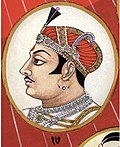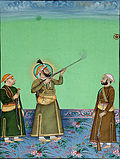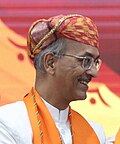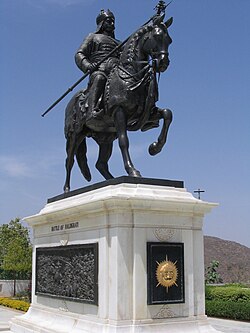| Portrait | King (Maharana) | Reign | Notes |
|---|
| Hammir Singh | 1326–1364 | He attacked Chittor in 1326 and re-took it from the Khiljis after the family lost it in 1303. Defeated Muhammad Bin Tughluq in SSingoli taking the sultan himself a prisoner of war. Captured Ajmer, Ranthambor, Nagaur and Sopore. |
| Kshetra Singh | 1364–1382 | Hammir's son, he captured Madalgarh and Bundi, completely annexed Ajmer. He also defeated Amin Shah of Malwa at the "Battle of Bakrole" and inflicted heavy casualties. His death can actually by as late as 1405. |
| Lakha Singh | 1382–1421 | Khsetra's son, he was defeated multiple battles by Zafar Khan of Gujrat, but the territories were recovered. He rebuilt temples and shrines destroyed by Allaudin Khilji. |
 | Mokal Singh | 1421–1433 | Lakha's son, he defeated the Sultan of Nagaur and Gujrat. Later the sultan of Gujrat invaded Mewar and during this invasion. He was assassinated by his uncles Chacha and Mera. |
 | Rana Kumbha | 1433–1468 | Mokal's son, he first attacked and killed his fathers assassins. Defeated the Sultans of Nagaur, Gujarat and Malwa. Mewar became the strongest kingdom in North India. Built multiple strong forts in Mewar. |
| Udai Singh I | 1468–1473 | Kumbha' son, he assassinated his father and was then defeated by his brother. |
| Rana Raimal | 1473–1508 | Son of Kumbha, he killed his brother for assassinating his father. Fought against Malwa sultanate. |
 | Rana Sanga | 1508–1527 | Raimal's son, defeated the Sultan of Gujrat, Malwa and Delhi. Under his rule Mewar reached its pinnacle in power and prosperity. Eventually defeated by Babur. [13] |
| Ratan Singh II | 1528–1531 | Sanga's son, defeated and killed by Bahadur Shah of Gujarat. |
| Vikramaditya Singh | 1531–1536 | Sanga's son, assassinated by his cousin Vanvir Singh. |
| Vanvir Singh | 1536–1540 | Usurper of the throne. Defeated and expelled by his cousin Udai Singh II. |
 | Udai Singh II | 1540–1572 | Sanga's son, defeated Vanvir. Fought against Mughals and was defeated in Siege of Chittorgarh. |
 | Maharana Pratap | 1572–1597 | Udai's son, notable for his military resistance against the Mughals. |
 | Amar Singh I | 1597–1620 | Pratap's son, notable for his struggle against Mughals. |
 | Karan Singh II | 1620–1628 | Amar's son, maintained good relations with Mughals, built many temples, forts and strengthened existing ones. |
 | Jagat Singh I | 1628–1652 | Karan's son, attempted to restore fort of Chittor but Shah Jahan blocked his attempt. |
 | Raj Singh I | 1652–1680 | Jagat's son, fought and defeated Mughals many times. Regained territory and increased the wealth of the kingdom. Fought against Aurangzeb. Eventually poisoned by Aurangzeb's loyalists. [22] [23] |
 | Jai Singh | 1680–1698 | Raj's son, struggled to regain captured parts of Mewar from Mughals. [25] |
 | Amar Singh II | 1698–1710 | Jai's son, invaded neighboring territories, formed an alliance against the Mughals with Jaipur and Marwar. Capitalized over a weak Mughal empire. |
 | Sangram Singh II | 1710–1734 | Amar's son, defeated Ranabaaz Khan at the Battle of Bandanwara. Reestablished relations with a weak Mughal emperor. |
 | Jagat Singh II | 1734–1751 | Sangram's son, started paying Chauth to the Marathas. Heavily invested in placing Sawai Madho Singh on the throne of Jaipur, eventually bankrupting Mewar. |
 | Pratap Singh II | 1751–1754 | Jagat's son. |
 | Raj Singh II | 1754–1762 | Pratap's son, paid heavy tribute to Maratha's, financially devastating Mewar. |
 | Ari Singh II | 1762–1772 | Raj's son, under him, Maratha's raided Mewar multiple times for not paying tribute. |
| Hamir Singh II | 1772–1778 | Ari's son, underaged when became Rana and died. |
 | Bhim Singh | 1778–1828 | Hamir's brother, under him Mewar was repeatedly raided by Pindaris, Marwar and Jaipur fought for his daughter Krishna Kumari. Accepted sub ordinance of East India Company. |
 | Jawan Singh | 1828–1838 | Bhim's son, abused alcohol, not interested in ruling Mewar. Mewar racked up a lot of debt under his rule. |
| Sardar Singh | 1838–1842 | Jawan's son |
 | Swarup Singh | 1842–1861 | Ruler during the Indian Rebellion of 1857. |
 | Shambhu Singh | 1861–1874 | Focused on reform of education and social reforms. |
 | Sajjan Singh | 1874–1884 | Shambhu's ruler. |
 | Fateh Singh | 1884–1930 | Sajjan's son |
 | Bhupal Singh | 1930–1948
1948–1955
(titular) | Signed the Instrument of Accession to India, dissolving his kingdom into the India. Titular ruler from 1955 |
| Titular Maharanas |
 | Bhagwat Singh | 1955–1984 | Lost the Privy Purse. |
 | Mahendra Singh | 1984–2024 | Bhagwat's elder son |
 | Vishvaraj Singh | 2024–present | Present ruler |



























